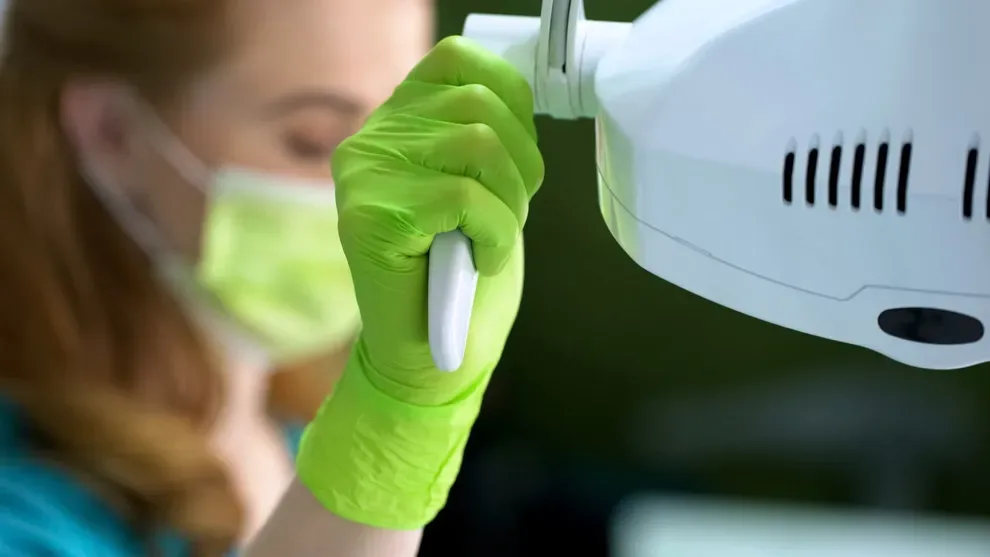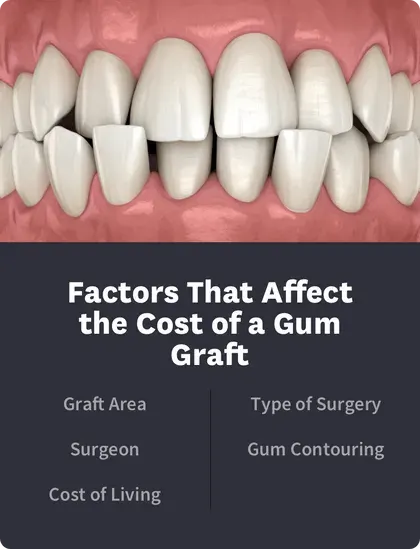How Much Does a Gum Graft Cost: With & Without Insurance

Table of Contents
- Gum Grafts
- Cost of a Gum Graft
- Types of Gum Grafts
- Procedural Costs
- Costs of Gum Graft (per area)
- Using Insurance Coverage
- Additional Payment Options
- Gum Graft Costs FAQs
- References
The cost of gum graft surgery will depend on how much area is affected and how much the gums have receded. On average, a gum graft can cost between $600 and $1,200 for a small area around one tooth.
Dental insurance often covers at least part of the cost of a gum graft. If it is deemed medically necessary, medical insurance may provide some coverage for gum graft surgery as well since it is a surgical procedure. There are also payment plans and additional options available to help cover the cost of a gum graft.
Gum Grafts
Gum tissue can recede or wear away from the teeth, which can expose the root and cause increased sensitivity. Eventually, if not treated, it can lead to tooth loss. Gum graft surgery can use healthy tissue to build the area back up.
Nearly half (47.2 percent) of the adult population, ages 30 and older, in the United States have some form of gum disease, or periodontal disease. Periodontal disease can cause the gums to pull away from the teeth, which can cause both cosmetic and medical issues.
Tooth sensitivity and bone and tooth loss can be side effects of receding gums. Recession of gums is a process that often happens slowly over time, so you may not even notice it until it has gone too far.
A gum graft can help to fix a receding gum line and alleviate these issues. It is a dental surgery that is usually performed by a periodontist who uses tissue from your mouth or a donor to cover the areas that are exposed. Typically, tissue is harvested from the roof of your mouth for a gum graft, but it can also be taken from a donor or a cadaver.
Gum graft surgery can improve your smile as well as enhance your periodontal health by covering exposed roots and protecting your teeth from further decay.
Cost of a Gum Graft

Gum graft costs can vary widely depending on a number of factors, including:
The area that needs to be grafted. This relates to the amount and severity of gum recession.
The type of surgery done. If tissue is harvested from your mouth, it is usually less expensive. Using a donor often adds to the expense.
The specialist performing the surgery. A periodontist generally charges more than a dentist.
The location of the office. Costs can range greatly based on geographical area.
If gum contouring is done at the same time. This procedure trims the gums for a more cosmetic appearance and increases the cost, often nearly doubling it.
If only one tooth and a small area is being grafted, a gum graft generally costs around $1,000. Larger areas and a more extensive surgery, especially if using a donor, will cost more.
One example of a gum grafting procedure is a connective tissue graft, and this is where a periodontist or dentist takes tissue from the roof of your mouth and places it over an exposed root.
Different Types of Gum Grafts
There are four common types of gum grafts:
This is the most common type of gum graft. The exposed gum root is covered by a small piece of tissue taken from under the surface of the roof of your mouth.
In this type of graft, a piece of tissue is taken from the actual roof of your mouth (your palate) to cover the exposed gum root.
If you have enough gum tissue in the direct vicinity of the affected gum root, your dentist or specialist may perform a pedicle graft, during which they’ll move gum tissue from a nearby area to cover the exposed root.
AlloDerm is a collagen material (registered and trademarked) that is placed over recessed gums to protect gum roots and restore gum health. An AlloDerm gum graft doesn’t require that tissue be taken from your mouth or another source.
Procedural Costs for a Gum Graft
In addition to the costs for the actual procedure, gum grafting treatment will also involve other treatment fees, which may include the following:
Initial exam and consultation
Dental cleaning: Individuals with heavy plaque or tartar buildup may require specialized cleaning, such as a dental deep cleaning (also called a scaling and root planing cleaning) or a gross debridement cleaning before continuing with treatment.
X-rays
Comprehensive periodontal examination
Anesthesia
Some people may also choose to get gum contouring treatment at the same time as their gum grafting. During gum contouring (or gum reshaping), your dentist or specialist will use tools and techniques to remove excess gum tissue or shape your existing gum tissue.
Gum contouring is not usually covered by insurance. It may cost around $1,000 to $3,000.
Overview: Costs of Gum Graft (per area)
| Average cost | |
|---|---|
| Connective-tissue graft | $600–$3,000 |
| Free gingival graft | $600–$3,000 |
| Pedicle graft | $600–$3,000 |
| AlloDerm gum graft | $600–$3,000 |
| Gum contouring | $1,000–$3,000 |
| Additional procedural fees | Initial exam and x-rays may cost over $500. Cleaning and specialized cleaning will cost more. Anesthesia and surgery fees will also add to cost. |
| Factors that increase cost of grafting treatment | Placement of gum tissue (harder-to-reach areas may take longer to treat and incur more expenses) If tissue needs to be acquired from a donor or cadaver If the procedure is performed by a specialist If gum problem is complicated and involves multiple tooth roots |
Using Insurance Coverage
Dental insurance will regularly cover at least part of a gum graft procedure if it is done for medical reasons and not just cosmetic purposes. When gum graft surgery is needed to cover exposed roots and prevent bone and tooth loss, it can also be partially covered through medical insurance.
Medical and dental insurance can vary widely based on your location, the provider, and your specific plan. You will need to contact your provider to get the details on your plan and find out how much, if any, of your gum graft surgery insurance can cover.
With insurance, the gum graft can be partially to fully covered. The amount you will have to pay out of pocket depends on your specific plan and level of coverage.
Additional Payment Options
Whether or not insurance covers a portion of your gum graft, you could still be looking at out-of-pocket expenses in the hundreds of dollars. If your gum graft is considered to be cosmetic, and therefore elective, it is not likely to be covered by insurance at all. In this case, you will be responsible for the entire amount.
There are a number of ways to help pay for these out-of-pocket costs.
Payment plans: Many dental and periodontal offices offer payment plans to allow you to pay for the procedure in installments over time.
Financing: Dental offices regularly have financing options to aid with payments.
Dental plans: There are a number of dental discount plans that are not the same as insurance, but they can offer you a deep discount on some dental procedures.
Health savings accounts (HSA): Since a gum graft is often classified as a medical procedure, you can use funds from your tax-free account to cover the costs.
Consider a second opinion and shop around. Gum grafts can range in cost in different places and with different specialists.
Gum Graft Costs Frequently Asked Questions
Even though gum grafts are not always medically necessary, any procedure that allows you to prevent age or lifestyle-related gum loss is a worthy pursuit. Thinning gums can be almost inevitable because of wear and tear from regular brushing. If your gums are thinning due to periodontal disease, it can be an even bigger concern.
Gum grafts are the most successful treatment for receding gums. They counteract the effects of gum disease and years of aggressive brushing. The procedure is safe and usually has a high success rate, although it does require a period of postoperative care to ensure proper tissue development and prevent complications like infections.
Gum grafts are normally covered by insurance. The cost of the procedure can be too expensive without insurance, especially when the area to be grafted is large. However, there are exceptions to coverage.
Coverage extends only to the part of the procedure that is deemed medically necessary and not performed for cosmetic reasons. In cases where the surgery entails covering exposed roots to prevent bone loss, gum grafts are partially covered through medical insurance.
With proper follow-up care, a well-performed gum graft lasts a lifetime. The procedure is usually permanent but only when the initial cause of gum recession is addressed first.
The lack of sutures and scalpel marks means that the healing process is rapid. Also, gum grafts tend to be kind on patients, which is why they’re easier to maintain and live with. The recovery stage is not short, but it’s usually comfortable.
